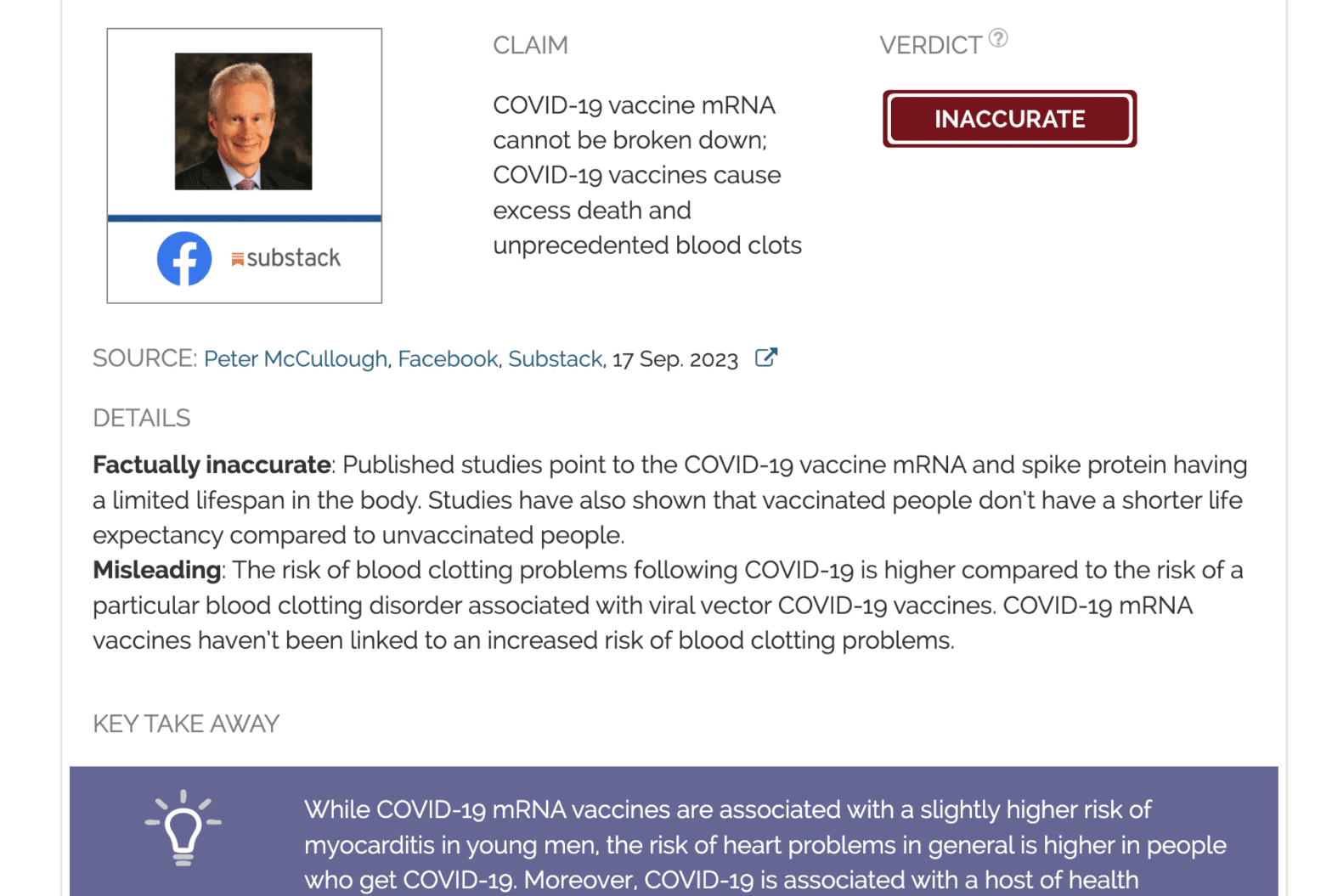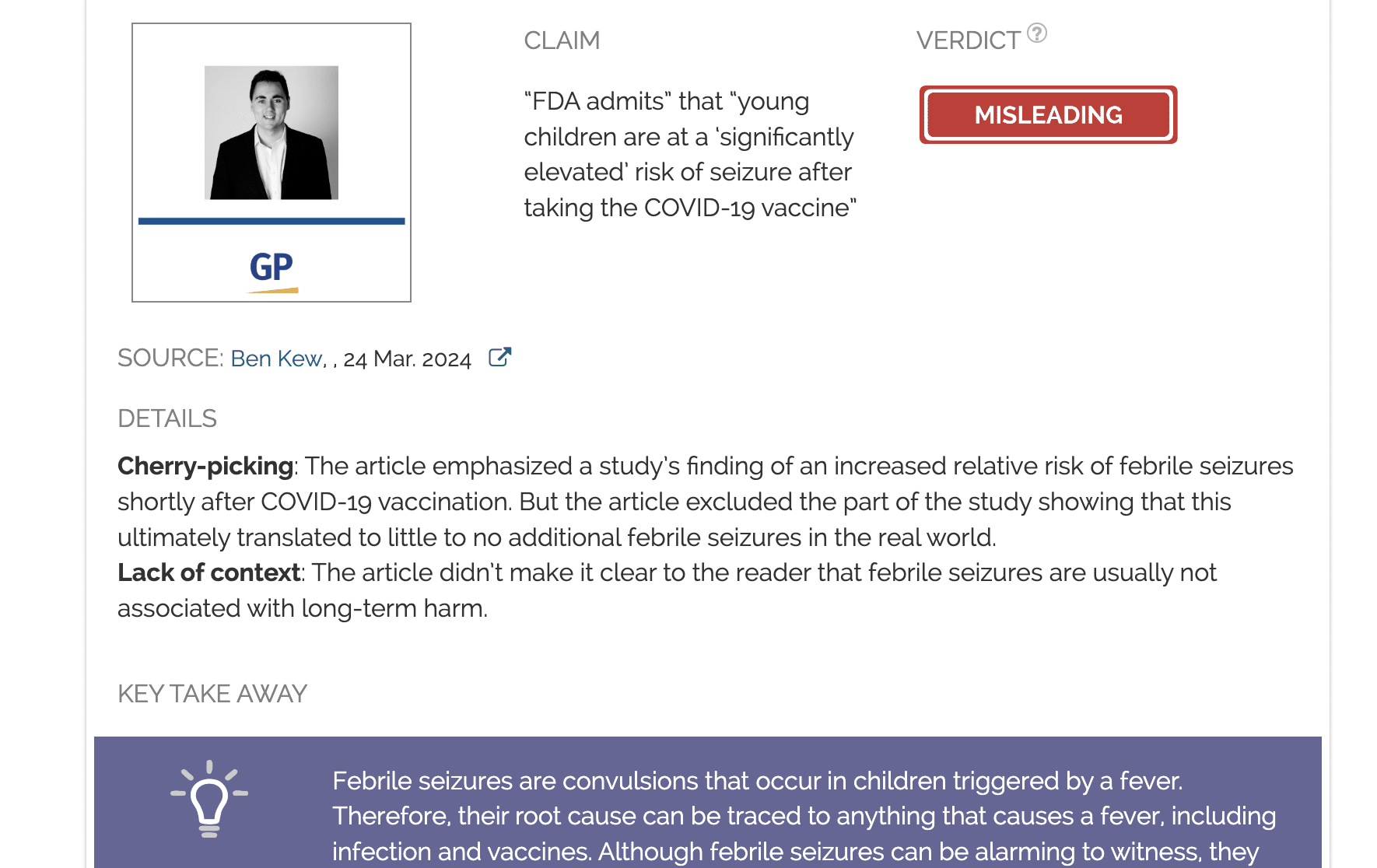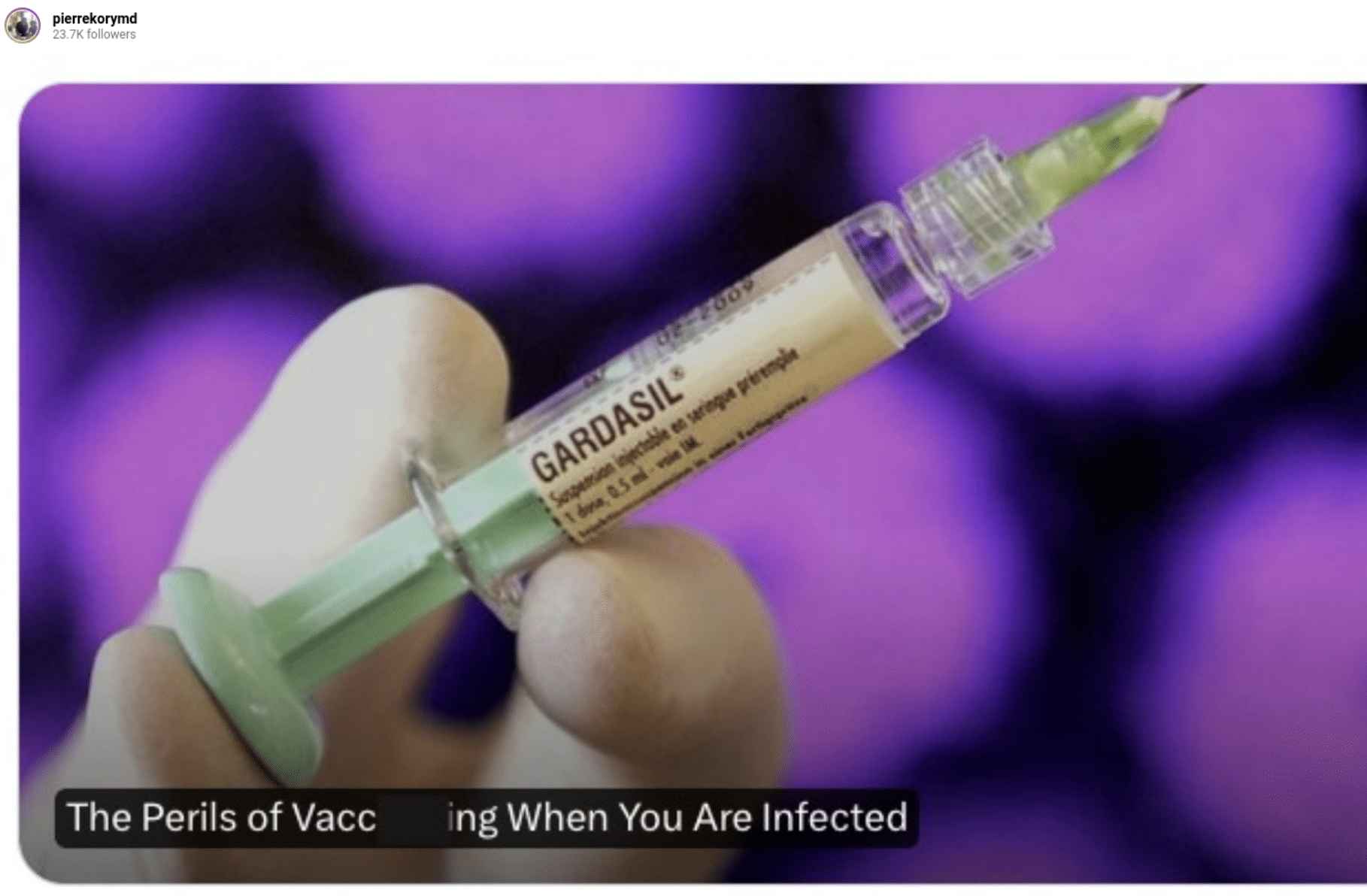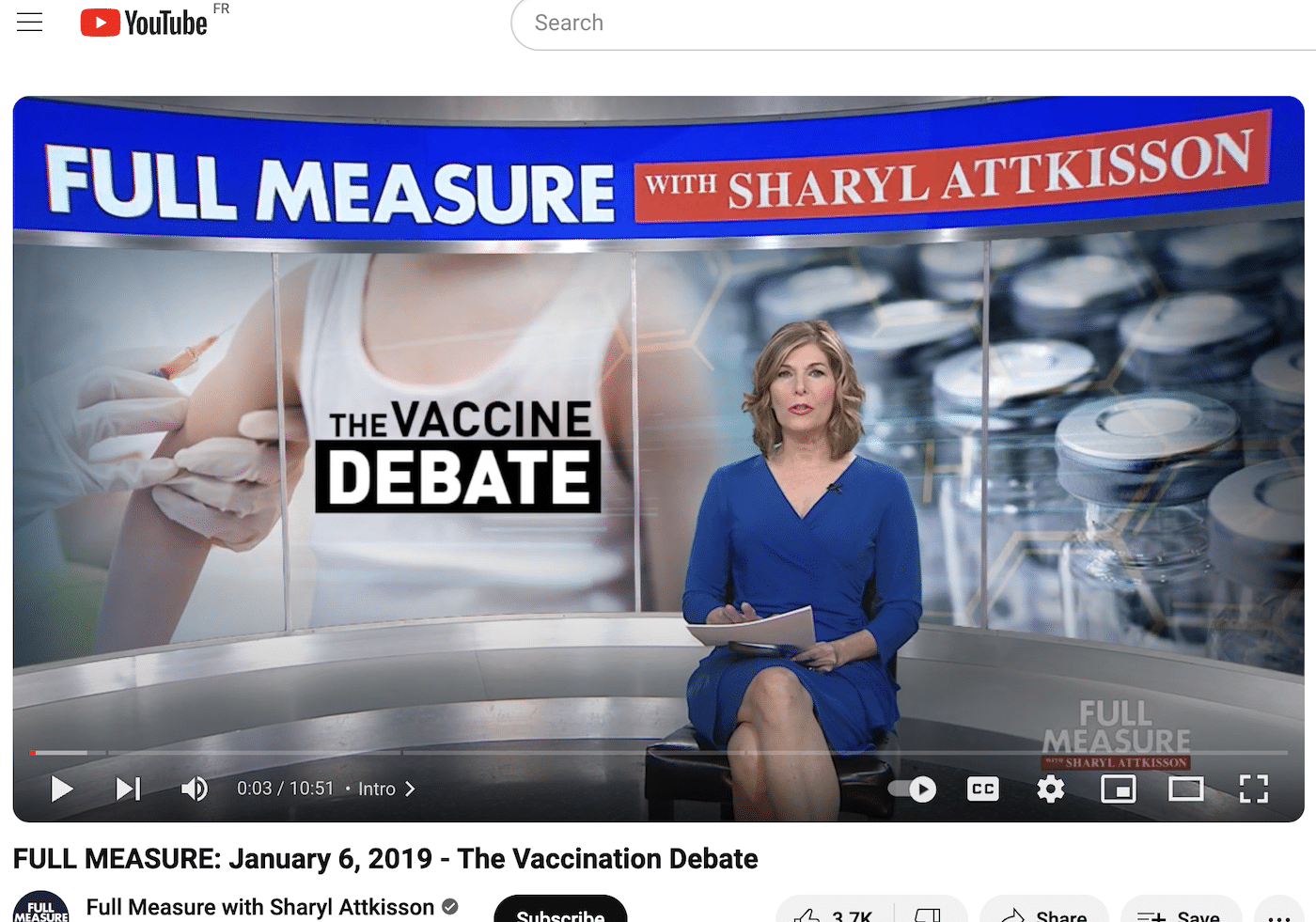- Health
Peter McCullough makes inaccurate and misleading claims about COVID-19 vaccines at event hosted by European political party
Key takeaway
While COVID-19 mRNA vaccines are associated with a slightly higher risk of myocarditis in young men, the risk of heart problems in general is higher in people who get COVID-19. Moreover, COVID-19 is associated with a host of health problems, of which heart problems are just one. Vaccination reduces the risk of infection and severe disease. As such, the vaccines’ benefit outweighs their risk.
Reviewed content

Verdict:
Claim:
COVID-19 vaccine mRNA cannot be broken down; COVID-19 vaccines cause excess death and unprecedented blood clots
Verdict detail
Factually inaccurate: Published studies point to the COVID-19 vaccine mRNA and spike protein having a limited lifespan in the body. Studies have also shown that vaccinated people don’t have a shorter life expectancy compared to unvaccinated people.
Misleading: The risk of blood clotting problems following COVID-19 is higher compared to the risk of a particular blood clotting disorder associated with viral vector COVID-19 vaccines. COVID-19 mRNA vaccines haven’t been linked to an increased risk of blood clotting problems.
Full Claim
“There’s not a single study showing that the messenger RNA is broken down”; “Our conclusion: 73.9% of the deaths after vaccination are due to the vaccine”; “Blood clots like we’ve never seen before. The spike protein is the most thrombogenic protein we’ve ever seen in human medicine. It’s found in the blood clots. The spike protein causes blood clots”
Review
A video circulating in late September 2023 allegedly showed cardiologist Peter McCullough addressing the European Parliament and calling for COVID-19 vaccines to be removed from the market. The video circulated on Facebook, YouTube, X (formerly Twitter), and Rumble, drawing more than 432,000 views to date.
Health Feedback previously addressed COVID-19 misinformation propagated by McCullough. McCullough works for the Wellness Company and has repeatedly promoted the sale of unproven supplements supposed to “detox” the spike protein. Experts have pointed out that detoxification is neither useful nor necessary for COVID-19 vaccination.
McCullough’s video is reminiscent of a video that circulated in May 2023, purportedly showing financial analyst David Martin addressing the European Parliament on the origins of COVID-19. This wasn’t the case, however. Martin had been speaking at an event hosted by some members of the European Parliament (MEPs), but this event wasn’t held in the Hemicycle where the more than 700 MEPs gather for plenary sessions, but in a smaller meeting room.
Likewise, claims that McCullough had addressed the European Parliament in the video are inaccurate. McCullough had been speaking at an event hosted by members of the Identity and Democracy party, which was held at the De Madariaga meeting room in the building of the European Parliament in Strasbourg, not the Hemicycle. This information was shown in his Substack post sharing the video.
As on previous occasions, McCullough made several unsubstantiated and false claims about the risks of COVID-19 vaccination in the video. We explain below.
Claim 1 (Factually inaccurate):
“There’s not a single study showing that the messenger RNA is broken down. Because it’s pseudouridinated, it’s made synthetically. It cannot be broken down. There’s not a study showing it leaves the body.”
The mRNA used in COVID-19 mRNA vaccines serves as a blueprint for teaching cells to make the spike protein of SARS-CoV-2. This enables our body’s immune system to learn how to respond to an infection by the virus.
Scientists modified the mRNA used to make the vaccine so that it would be stable enough to fulfill its function. This includes using a molecule called pseudouridine[1], which McCullough referred to in his statement. These modifications aren’t exclusively artificial—they also occur naturally in our body. In fact, naturally-occurring mRNA modifications were what inspired the modifications made by scientists.
McCullough’s claim implied that the mRNA modifications render vaccine mRNA practically indestructible. This isn’t true, however. Contrary to the claim that no study shows the mRNA leaving the body, there have been published studies pointing to the limited lifespan of vaccine mRNA.
Fertig et al. measured the amount of vaccine mRNA in the blood of 16 healthy individuals who’d received the Pfizer-BioNTech COVID-19 vaccine, and found that vaccine mRNA levels fell over the course of the two weeks after vaccination[2].
Ogata et al. studied 13 mRNA-vaccinated individuals and found that spike protein was virtually undetectable in the blood of most of them a week after vaccination[3].
Another study by Castruita et al. also examined vaccine mRNA in the blood post-vaccination. Vaccine mRNA was detected initially for all the vaccinated individuals, but at 28 days after vaccination, vaccine mRNA was still detectable in the blood of only 10 of the 108 individuals[4]. But it is important to note that all the individuals in the study had chronic hepatitis C infection and, therefore, might not represent the general population.
Neither Castruita et al. nor Ogata et al. reported any detrimental effect associated with the presence of vaccine mRNA and vaccine-associated spike protein in people’s blood.
Roeltgen et al. reported that vaccine mRNA remained in the lymph nodes of vaccinated people for up to 60 days after the second dose, although the amount of mRNA detected fell over time[5]. It should be noted that the findings were specific to the lymph nodes, where antibody-producing cells refine their ability to recognize pathogens. The role of the lymph nodes in our immunity means the persistence of the vaccine mRNA and spike protein isn’t unexpected.
Scott Boyd, the senior author of the study and a professor at Stanford University, explained the group’s findings on X (formerly Twitter). Boyd stated that “Lymph nodes are the desired destination for vaccine antigens, because that is where antibody producing responses are organized” and that they didn’t find evidence that the persistence of vaccine mRNA in the lymph nodes “is a harmful event”.
In summary, the claim that no study shows vaccine mRNA leaves the body is simply false.
Claim 2 (Incorrect):
“I’m the senior author on the largest autopsy study ever assembled of death after Covid-19 vaccination. Worldwide. We searched the literature, 600 papers, all the clinical findings, we reviewed them with contemporary knowledge, experts in pathology and clinical medicine. Our conclusion: 73.9% of the deaths after vaccination are due to the vaccine.”
Health Feedback reviewed the claims of this study at length in a previous review. The study is in fact, a preprint (a scientific manuscript that hasn’t been peer-reviewed by other experts). It was originally uploaded to the Social Science Research Network (SSRN), a preprint server associated with The Lancet, and removed a day later “because the study’s conclusions are not supported by the study methodology”. It is now hosted on another preprint server, Zenodo.
The preprint authors searched for studies of autopsies on people who died after COVID-19 vaccination. McCullough cited a figure of 600 papers, which requires some context. While the authors had initially identified 678 studies, more than 500 were duplicates and removed from the analysis, as the preprint stated. So the authors ultimately didn’t review 600 studies, but 134 instead.
And of the 134 studies, the authors only included 44 studies in their analysis. Some studies had been excluded because they hadn’t conducted an autopsy or didn’t report vaccination status, but others were excluded without a clear reason.
Given that including or excluding a large number of studies from analysis can significantly influence the results, sound inclusion and exclusion criteria are important to ensure the objectivity of the analysis. But this doesn’t appear to have been the case with the preprint.
Doubt over the objectivity of the analysis also comes from the individuals who reviewed the studies and determined whether COVID-19 vaccination was responsible for the death: William Makis, Roger Hodkinson, and McCullough himself. All three have propagated COVID-19 vaccine misinformation.
Brian Ward, a professor of experimental medicine and vaccine scientist at McGill University, told AFP that he questioned whether the researchers were actually independent, as they claimed to be in the preprint, as their track record of spreading COVID-19 misinformation could motivate them to reach a conclusion in line with their expressed views on the vaccines.
Zhou Xing, an immunologist and professor at McMaster University, told AFP that the authors hadn’t considered existing medical conditions and age as possible causes of death. He called the analysis “astoundingly ridiculous”.
Finally, the fact that a person died after COVID-19 vaccination alone isn’t sufficient evidence for the claim that COVID-19 vaccines caused their death. Health Feedback wrote extensively about vaccine adverse event reports and how they are often misinterpreted here. Mitchell Levine, a professor of medicine and health research methods at McMaster University, told Logically Facts that case reports, like those used in the preprint, are “completely useless for assessing associations, causal or otherwise”.
Claim 3 (Misleading):
“Now the World Council for Health, which is a multinational, evidence-based, physician and healthcare provider organization, on June 11, 2022, issued a pharmacovigilance report looking at 39 safety databases, including the WHO Vigisafe and the EMA databases and the US databases, and their conclusion was to remove all the COVID-19 vaccines off the market for excess risk of death.”
The World Council for Health was co-founded by individuals who have propagated COVID-19 misinformation, including physicians Tess Lawrie and Mark Trozzi. The group has ties to Pandata and the U.K.-based HART group, both of which are associated with disinformation campaigns about COVID-19 and COVID-19 vaccines.
The so-called “pharmacovigilance report” concluded that COVID-19 vaccines should be recalled on account of the number of “adverse events reports linked to Covid-19 vaccines that are between ten times and 169 times more than what is observed” in other vaccines.
But the problem with comparing COVID-19 vaccine reports to those of other vaccines is that it fails to account for the difference in adverse event reporting rates. For example, COVID-19 vaccines have been under intense scrutiny, and potential side effects were widely reported in the media.
There are also instances in which public health authorities encouraged people to report adverse events following vaccination, leading to increased awareness of adverse event reporting programs.
And in the case of the U.S. VAERS database at least, reporting serious adverse events following COVID-19 vaccination, including death, is mandatory regardless of the cause, unlike for previous vaccines.
Hence, comparing the raw number of adverse event reports between the COVID-19 vaccines and previous vaccines is comparing apples and oranges.
The U.K.’s Medicines and Healthcare products Regulatory Agency (MHRA), which runs the Yellow Card scheme, states that “The total number and the nature of the majority of Yellow Cards reports received so far is not unusual for a new vaccine for which members of the public and healthcare professionals are encouraged to report any suspected adverse reaction”.
Moreover, published studies have shown that vaccinated people aren’t more likely to die compared to unvaccinated people. A CDC study examining the period between December 2020 and July 2021[6] found that COVID-19 vaccine recipients had lower rates of non-COVID-19 mortality.
Another study looked at excess mortality in the U.S. and other peer countries between June 2021 and March 2022. It found that excess all-cause mortality was greater in the ten least-vaccinated states than in the ten most-vaccinated states[7].
Another study in the state of Indiana, which included more than 520,000 people, compared vaccinated people with unvaccinated, previously infected people. The study actually found that all-cause mortality was 37% lower in the vaccinated group[8].
In summary, McCullough’s claim is based on a misleading comparison of raw numbers of adverse event reports. It is also inconsistent with studies showing that vaccinated people don’t experience a higher mortality rate compared to unvaccinated people.
Claim 4 (Unsupported):
“Blood clots like we’ve never seen before. The spike protein is the most thrombogenic protein we’ve ever seen in human medicine. It’s found in the blood clots. The spike protein causes blood clots. Blood clots larger and more resistant to blood thinners than we’ve ever experienced in human medicine.”
McCullough offered no evidence to substantiate these hyperbolic claims. While viral vector COVID-19 vaccines, like the Oxford-AstraZeneca vaccine, are associated with a slightly increased risk of a particular blood clotting disorder known as vaccine-induced immune thrombotic thrombocytopenia, it’s still unclear exactly why the vaccine causes this problem in a small number of people who received the vaccine.
Research is still ongoing, but one group at Cardiff University found that the viral vector—the adenovirus used to carry the spike protein blueprint into cells—could trigger an abnormal immune response that causes platelets to clump together, leading to blood clotting[9].
In summary, the exaggerated claims by McCullough aren’t supported by scientific evidence, and they gloss over the fact that COVID-19 itself is associated with a higher risk of blood clotting disorders, as well as cardiovascular problems, compared to COVID-19 vaccination[10-16].
Claim 5 (Misleading and Unsupported):
“A few important papers to finish. One is by Schmeling and colleagues from Denmark demonstrating that about 30% of people who have taken a vaccine have zero side effects […] And then there’s the small third batch group, 4.2% in the Schmeling data, it’s through the roof, myocarditis, cardiac arrest, blood clots, hemorrhagic stroke, disabilities. Sudden death at home in bed.”
Health Feedback covered the claims regarding a research letter by Schmeling et al. at length in an earlier review.
In their letter, which was submitted to the European Journal of Clinical Investigation, Schmeling et al. alleged that there was a wide variation in the number of suspected adverse events associated with different batches of the COVID-19 vaccine, and that this constituted a “batch-dependent safety signal”.
They arrived at this conclusion by analyzing the number of suspected adverse events (SAEs) associated with more than 50 batches of the Pfizer-BioNTech COVID-19 vaccine, using publicly available data from the Danish Medicines Agency.
Anders Hviid, the head of epidemiology research at the Statens Serum Institute and a professor of pharmacoepidemiology at the University of Copenhagen, refuted these claims in a letter to the editor of the journal.
In the letter, Hviid pointed out that the authors had incorrectly described the data they used:
“They report that they have received batch-specific information on adverse event reports from the Danish Medicines Agency and administered vaccines from Statens Serum Institut (SSI). This is not correct. The information they have obtained from SSI is on shipped vaccine vials by batch number.”
He elaborated further:
“From SSI, vaccines were shipped to regional distribution centres (with −90 degree celsius storage capacity). The dates of data retrieval for both sources of data used in the letter are 18 January 2022 (shipment volumes) and 11 January 2022 (adverse event reports). Thus, batches shipped late in 2021 or very early in 2022 will not have any or very few adverse event reports, because they have not been used or only a small proportion have been used. This is also clearly seen in the figure in the letter, where the so-called ‘yellow’ batches have zero or close to zero reports. Understanding this is critical for the interpretation of these results. This is a particularly serious issue as the crux of the letter hinges on the idea that different vaccine batches have drastically different safety profiles which is not supported at all when you understand that it is not administered vaccines as they claim.”
He also added:
“There are many other issues with respect to these data. For example, that the very first batches were small, administered during the introduction period where clinical practitioners were instructed to report everything including local reactions, fever, transient headache, etc. These cannot be compared to later only partially used batches, where the authorities urged that mild and transient events should no longer be reported. It is also well-known that in the early part of the vaccination deployment, those vaccinating were urged to attempt to get seven doses out of the vials instead of six due to supply concerns. Again, as the authors do not have data on administered doses but only on shipped vials, the comparisons are further skewed.”
Hviid concluded by stating:
“In summary, the research letter is presenting the study data inaccurately and has a number of reporting inconsistencies that should also be corrected and even so the study data cannot be used to provide any meaningful insights into batch variability with respect to safety.”
It is also unclear how McCullough knew what the nature of the suspected adverse events were, with his claim that “myocarditis, cardiac arrest, blood clots, hemorrhagic stroke, disabilities, sudden death at home in bed” were “through the roof”, given that Schmeling et al. never described the suspected adverse events in their letter at all.
Health Feedback reached out to McCullough for comment and will update the review if new information becomes available.
Conclusion
The video showed McCullough speaking at an event hosted by an European political party. He didn’t address the European Parliament, contrary to popular claims otherwise.
As explained above, McCullough’s claim that the COVID-19 vaccines are unsafe is based on misleading interpretations of vaccine adverse events and flawed analyses of autopsies and vaccine adverse events. His claims generally ignored the wide body of scientific studies showing that vaccine mRNA isn’t associated with harm and that COVID-19 vaccination isn’t linked to an increased risk of all-cause mortality.
Like all medical interventions, COVID-19 vaccines come with side effects. COVID-19 mRNA vaccines have been associated with a slightly elevated risk of heart inflammation particularly in young males, but COVID-19 itself is linked to a higher risk of heart problems and other health problems. The vaccines are highly effective at reducing the risk of severe disease and death. On balance, their benefit outweighs their risk.
REFERENCES
- 1 – Nance and Meier. (2021) Modifications in an Emergency: The Role of N1-Methylpseudouridine in COVID-19 Vaccines. ACS Central Science.
- 2 – Fertig et al. (2022) Vaccine mRNA Can Be Detected in Blood at 15 Days Post-Vaccination. Biomedicines.
- 3 – Ogata et al. (2021) Circulating Severe Acute Respiratory Syndrome Coronavirus 2 (SARS-CoV-2) Vaccine Antigen Detected in the Plasma of mRNA-1273 Vaccine Recipients. Clinical Infectious Diseases.
- 4 – Castruita et al. (2023) SARS-CoV-2 spike mRNA vaccine sequences circulate in blood up to 28 days after COVID-19 vaccination. Journal of Pathology, Immunology and Microbiology.
- 5 – Roeltgen et al. (2022) Immune imprinting, breadth of variant recognition, and germinal center response in human SARS-CoV-2 infection and vaccination. Cell.
- 6 – Xu et al. (2021) COVID-19 Vaccination and Non–COVID-19 Mortality Risk — Seven Integrated Health Care Organizations, United States, December 14, 2020–July 31, 2021. Morbidity and Mortality Weekly Report.
- 7 – Bilinski et al. (2023) COVID-19 and Excess All-Cause Mortality in the US and 20 Comparison Countries, June 2021-March 2022. JAMA Network.
- 8 – Tu et al. (2023) SARS-CoV-2 Infection, Hospitalization, and Death in Vaccinated and Infected Individuals by Age Groups in Indiana, 2021‒2022. American Journal of Public Health.
- 9 – Baker et al. (2021) ChAdOx1 interacts with CAR and PF4 with implications for thrombosis with thrombocytopenia syndrome. Science Advances.
- 10 – Douillet et al. (2021) Risk of symptomatic venous thromboembolism in mild and moderate COVID-19: A comparison of two prospective European cohorts. Thrombosis Research.
- 11 – Raisi-Estabragh et al. (2022) Cardiovascular disease and mortality sequelae of COVID-19 in the UK Biobank. Heart.
- 12 – Knight et al. (2022) Association of COVID-19 With Major Arterial and Venous Thrombotic Diseases: A Population-Wide Cohort Study of 48 Million Adults in England and Wales. Circulation.
- 13 – Hippisley-Cox et al. (2021) Risk of thrombocytopenia and thromboembolism after covid-19 vaccination and SARS-CoV-2 positive testing: self-controlled case series study. BMJ.
- 14 – Xie et al. (2022) Long-term cardiovascular outcomes of COVID-19. Nature Medicine.
- 15 – Patone et al. (2022) Risk of Myocarditis After Sequential Doses of COVID-19 Vaccine and SARS-CoV-2 Infection by Age and Sex. Circulation.
- 16 – Barda et al. (2021) Safety of the BNT162b2 mRNA Covid-19 Vaccine in a Nationwide Setting. New England Journal of Medicine.



